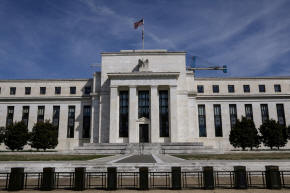The Fed's racing to raise rates, but how high remains an open bid
 Send a link to a friend
Send a link to a friend
 [April 28, 2022] By
Ann Saphir and Howard Schneider [April 28, 2022] By
Ann Saphir and Howard Schneider
(Reuters) - U.S. Federal Reserve officials
have aligned around plans to accelerate the pace of interest rate hikes
this year but remain split over what could be the make-or-break decision
of where to stop to avoid dragging the economy into recession.
That debate is only beginning but will become more critical this summer
as policymakers gauge how quickly their initial rate increases cause
households and firms to slow spending and whether that, in turn, slows
the pace of inflation running at levels not seen since the 1980s.
A recent rise in long-term interest rates has done little yet to improve
the inflation outlook and left the Fed at a risky juncture - torn
between an even more aggressive pace of rate hikes that may push the
economy backwards, or moving too slowly and allowing an inflationary
psychology to take hold.
"Ultimately itís making a decision...'this is a path that seems
consistent (with controlling inflation)'...Or judging that it's not the
case," Chicago Fed President Charles Evans said last week, outlining the
struggles Fed officials anticipate in determining how high rates may
need to rise to bring inflation back in line with the central bank's 2%
target.
"Itís a devilishly hard question," Evans said.

The current economic expansion depends on the Fed getting the answer
right, and not everyone thinks they will.
Former Treasury Secretary Lawrence Summers, who has argued forcefully
the Fed waited too long to respond to price increases, recently wrote
that inflation this high - last at 6.4% by the Fed's preferred measure -
coupled with low unemployment makes a recession likely within two years.
GRAPHIC: "Broad-based" or not? "Broad-based" or not? -
https://graphics.reuters.com/USA-FED/INFLATION/klpykzrowpg/
chart.png
'EXTREMELY IMPORTANT DEBATE'
The Fed will take the next step in its policy shift during a meeting May
3-4 when officials are expected to increase the target policy rate by
half a percentage point.
Even the most dovish policymakers, including Evans, now agree that rate
hikes in increments beyond the familiar quarter-point-per-meeting are
needed, given the strength of inflation. They also have coalesced around
an overall increase of the federal funds rate to at least 2.5% by year
end from the near-zero level set to fight the steep but brief recession
caused by the coronavirus pandemic.
Consumers, businesses and financial markets have largely taken that much
tightening in stride.
But it may not prove enough. Analysts note that periods of high
inflation can generate their own momentum, lifting the effective level
of rates needed to blunt price increases.
The rate where interest rate increases meaningfully influence the
economy "could be higher than it otherwise would be because of what's
going on with inflation, and that's partly what's driving them to be
more comfortable with going higher, faster," Nomura Research economist
Robert Dent said. "It's an extremely important debate that will get more
attention at the Fed in the next six months."

At their last meeting in March, the range of rates policymakers
projected as appropriate by the end of 2023 ran from 2.1% to 3.6%, a
cavernous gap reflecting risks around the pandemic, the Ukraine war, and
other largely uncontrollable forces, but also pointing to uncertainty
over how businesses and consumers might react to higher borrowing costs.
Equity markets have been rocked by volatility in recent days in part,
Bank of America economists argued in an analysis, because the berth
around possible Fed policy paths is currently so wide, with options
contracts indicating the central bank's policy rate could top out
anywhere between 2% and 4.5% over the next two years.
GRAPHIC: A fast trip to neutral -
https://graphics.reuters.com/USA-ECONOMY/POWELL/
zdvxogolapx/chart.png
FINDING 'NEUTRAL'
In debating monetary policy Fed officials use a concept known as the
"neutral" or "natural" rate of interest to judge whether the rate they
set for overnight loans between banks, a key figure that influences
borrowing costs more broadly, is encouraging or discouraging economic
activity.
[to top of second column] |

The Federal Reserve Board building on Constitution Avenue is
pictured in Washington, U.S., March 27, 2019. REUTERS/Brendan
McDermid/File Photo

Over the long-term it is the rate considered to balance the economy across a
number of fronts while maintaining full employment, inflation at the Fed's
target, and output growing at a rate consistent with underlying productivity,
demographic and other trends.
GRAPHIC: ICE inflation expectations index ICE inflation expectations index -
https://graphics.reuters.com/USA-FED/INFLATION/akvezxjwrpr/
chart.png
Fed officials currently estimate the neutral rate to be around 2.4% and have
committed as a group to reach that level "expeditiously" in one of the fastest
monetary policy shifts ever undertaken by the U.S. central bank.
But if the next few weeks or months veer from the Fed's baseline outlook - if
consumers alter their spending or businesses begin setting wages and prices
differently than anticipated because their own expectations or preferences have
shifted - policymakers may have to get more aggressive.
As a short-term concept, "neutral" may have moved higher because of the very
inflation dynamics the Fed is trying to fight, potentially forcing the central
bank to play catch-up. Some, like St. Louis Fed President James Bullard, argue
they are in fact already "behind the curve" and may need to move rates faster
and higher than planned.
GRAPHIC: A bumpy landing? -
https://graphics.reuters.com/USA-ECONOMY/RECESSIONTEMPLATE/
egpbkoolgvq/chart.png
'WALL OF WORRY'
Fed officials want to keep the recovery on track and avoid in particular any
large jump in unemployment from the current 3.6%, arguably the strongest job
market since the 1950s.

But that means they need to take the edge off some of the current economy's
extremes, be it the 35% jump in median home prices during the pandemic, or wage
increases that Fed Chair Jerome Powell has dubbed "unsustainably hot."
GRAPHIC: Fed policy trails inflation by historic margin Fed policy trails
inflation by historic margin - https://graphics.reuters.com/USA-FED/gdpzynrmnvw/chart.png
Inflation data this week will show whether any progress is being made, and the
April employment report released next week will provide an update on wage
growth.
There is some initial evidence the housing market is beginning to cool as home
mortgage rates exceed 5%, compared with around 3% last year.
But the issues around the Fed's policy path are still far from resolved. Many
economists recently raised their estimates of how much the Fed will need to do
and look to next week's meeting for guidance.
The job market and related wage growth remain strong, and unemployment could dip
below 3% this year, Jefferies economists projected recently. Consumers so far
have been impervious to "Omicron, Ukraine invasion, a spike in gas prices and
sharply higher interest rates," economists Aneta Markowska and Thomas Simons
wrote.
For the Fed that could mean pushing rates to more than 4%, a level not seen
since before the 2007-to-2009 financial crisis and one that would likely raise
recession risks.
"The U.S. economy is climbing the wall of worry," they wrote, with inflation
broadening and the economy's underlying strength meaning that "the Fed will have
to be even more aggressive."
(Reporting by Ann Saphir in San Francisco and Howard Scheider in Washington;
Editing by Dan Burns and Andrea Ricci)
[© 2022 Thomson Reuters. All rights
reserved.]This material may not be published,
broadcast, rewritten or redistributed.
Thompson Reuters is solely responsible for this content.
 |